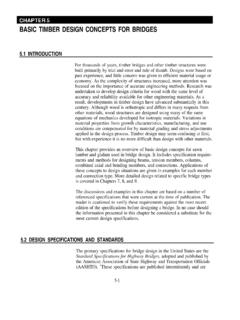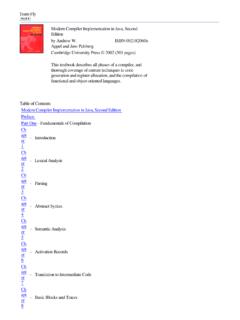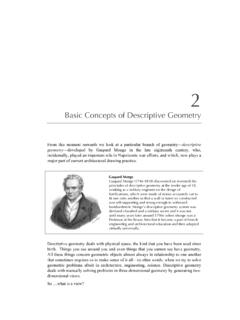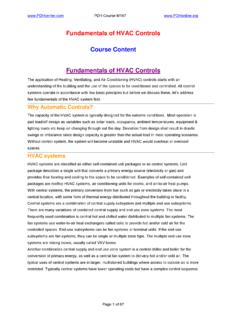Transcription of Soils – Fundamental Concepts
1 NRCS soil : Fundamental Concepts Scoop on soil Educational CD May 2006 NRCS Helping People Help the Land Soils Fundamental Concepts The soil In Perspective: A Fundamental knowledge of soil science is a prerequisite to meeting the many natural resource challenges that will face humanity in the 21st Century. It is also true that the study of Soils can be both fascinating and intellectually satisfying. It is in the Soils that we are able to observe all of the principles of biology, chemistry, and physics at work. It is the understanding of these principles which enables us to minimize the degradation and destruction of one of our most important natural resources.
2 Much of our life s activities and pursuits are related to and influenced by the behavior of the soil around our houses, roads, septic and sewage disposal systems, airports, parks, farms, forests, schools, and shopping centers. It is essential that conservation professionals understand the Soils on which we build and design and work. In any field of natural resources, it is important to understand the soil properties which impact the application of technology as we use it to preserve and protect our most basic natural resource, our Soils . soil Defined: We have several definitions of soil depending on the discipline providing the definition: Geologic definition loose surface of the earth as distinguished from solid bedrock.
3 (Support of plant life not required) Traditional definition material which nourishes and supports growing plants. (Includes rocks, water, snow, and even air all of which are capable of supporting plant life) Component definition mixture of mineral matter, organic matter, water and air. (Example: Loam soil = 45% mineral matter, 5% organic matter, 25% water, and 25% air). (Figure 1). soil Taxonomy definition collection of natural bodies of the earth s surface, in places modified or even made by man or earthy materials, containing living matter and supporting or capable of supporting plants out-of-doors.
4 Its upper limit is air or shallow water. At its margins it grades to deep water or to barren areas of rock or ice. Its lower limit is the lower limit of biologic activity, which generally coincides with the common rooting depth of native perennial plants, the depth to which soil weathering has been effective, or both. As a Portion of the landscape collection of natural bodies occupying portions of the earth s surface that support plants and that have properties due to the integrated effect of climate and living matter, acting upon parent material, as conditioned by relief, over periods of time.
5 NRCS soil : Fundamental Concepts Scoop on soil Educational CD May 2006 NRCS Helping People Help the Land Figure 1: Composition of Average soil The soil Profile: A soil is a three-dimensional natural body in the same sense that a hill, valley, or mountain has three dimensions. By digging or augering a hole in the soil , you may retrieve some soil material, and, you can take this sample of soil material into the laboratory and analyze its contents, but you must go into the field to study a soil as a natural body.
6 Soils occur on landscapes and are delineated on aerial photographs by trained soil scientists. These delineations are called polygons or polypedons, and they represent soil areas that are similar with regard to the intended uses of that soil . Polypedons have many pedons ( soil profiles) included within their boundaries. See Figure 2 for a schematic of this relationship. Air 25% Water 25% Mineral Matter 45% Organic Matter 5% NRCS soil : Fundamental Concepts Scoop on soil Educational CD May 2006 NRCS Helping People Help the Land Figure 2: Relationship of Landscapes to soil polygons and a soil profile (pedon).
7 Soils range in depth form just a few inches to tens of meters and in may instances they have been transported many kilometers from the site of their initial formation and then deposited over materials such as bedrock which is much different than the original source of the soil materials. The effects of five soil forming factors alter the soil material: climate, time, relief, organisms, and parent material. These factors act together to differentiate individual bodies of soil . This is accomplished through four basic processes acting on the parent material to alter its properties and differentiate one soil from another.
8 These are (A) Translocations, (b) Transformations, (c) Additions, and (d) Losses. (Figure 3). Figure 3: soil forming processes NRCS soil : Fundamental Concepts Scoop on soil Educational CD May 2006 NRCS Helping People Help the Land It is the interaction of these soil forming factors in various combinations that gives us the great variety of Soils we see today. There are many variations within each factor, and even if there were only 10 gradations in each factor, there would be 105, or 100,000 different combinations, which would mean 100,000 different Soils .
9 In truth, no two Soils are expected to be just alike, but Soils , which are similar, are grouped together for purposes of classification for cultural practices and uses. We will discuss these factors in more detail in a later module. The effects of these soil forming factors (weathering) results in the formation of layers within the soil from the surface down to varying depths depending on the intensity of the weathering. These layers are called horizons. The combination of these layers in a sequence from the surface of the soil down represents a soil profile. Road cuts and other man made excavations can expose soil profiles and serve as windows to the soil .
10 Observing how Soils exposed in these excavations vary from place to place can add a fascinating new dimension to our understanding of Soils . Once you have learned to interpret the different horizons, soil profiles can warn you about potential problems in using the land as well as tell you about the environment and history of the region. For example, Soils developed under grasslands may have a very different soil profile than those developed under forestland. The layers in a soil profile are called horizons. Horizons within a soil survey vary in thickness and have somewhat irregular boundaries, but all of the boundaries generally parallel the earth s surface.






